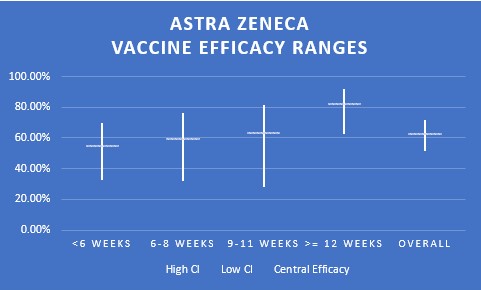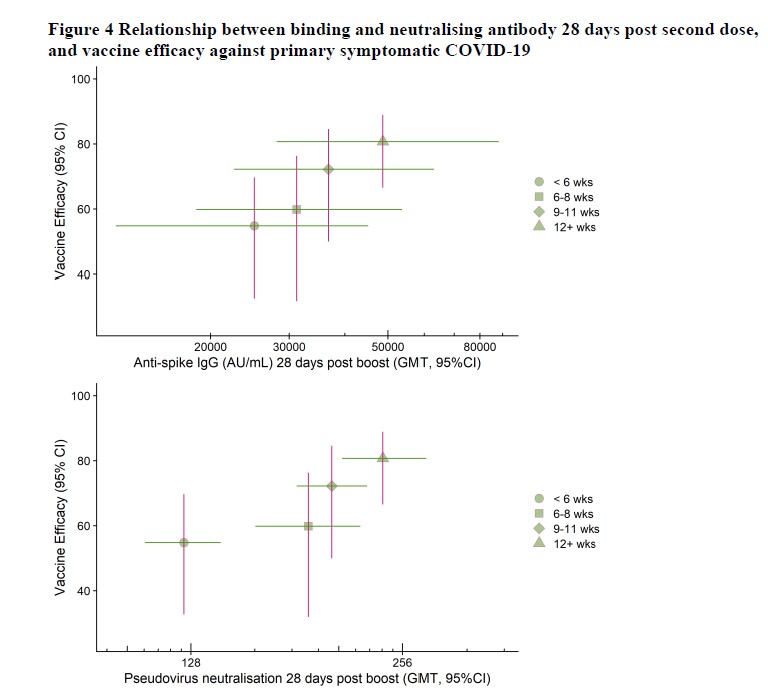Just how effective is the Astra Zeneca vaccine? Better than a flu vaccine, but not as good as Pfizer or Moderna. The Australian government is quoting efficacy of 82%, which is the results of a subset of the clinical trial results – what happens with two standard doses, at least 12 weeks apart. Because it’s only a subset of the full clinical trial, the range of possible outcomes around that 82% is quite wide – 63% to 92%. I would take it if it was offered to me.
In the week the Australian TGA approved the Astra Zeneca vaccine, I thought I’d have a look at the Astra Zeneca statistics.
When the results started coming in, I posted about the first two mRNA vaccines here. Pfizer and Moderna were both more than 90% effective from their initial clinical trials (before the new UK and South African variants).
What does 82% efficacy mean? If 100 people would have been ill with Covid19 without the vaccine, only 18 would be ill with Covid19 after receiving the vaccine. The efficacy measure doesn’t differentiate between severity of illness, but in all vaccine analyses (not just Astra Zeneca), the results of the studies suggest that the vaccine also reduces the severity of symptoms without enough severe cases to say that with any statistical accuracy. The efficacy measure also says nothing about whether the vaccine affects the transmission of the virus. If the vaccine converts a sick person into someone who is asymptomatic, but still transmits the virus, that is good for that individual person, but less useful for society than if the vaccine prevents infection entirely (as herd immunity relies on people not transmitting the virus).
Astra Zeneca recently announced an update of their confusing initial clinical trial results here, based on data up to 7th December (so mostly without the new variants).
The primary analysis of the Phase III clinical trials from the UK, Brazil and South Africa, published as a preprint in The Lancet confirmed COVID-19 Vaccine AstraZeneca is safe and effective at preventing COVID-19, with no severe cases and no hospitalisations, more than 22 days after the first dose.
Results demonstrated vaccine efficacy of 76% (CI: 59% to 86%) after a first dose, with protection maintained to the second dose. With an inter-dose interval of 12 weeks or more, vaccine efficacy increased to 82% (CI: 63%, 92%).
There’s a lot to unpack here, and that’s before you get to the new variants. I’m just going to look at their testing of the standard two dose regimen, and the results that have led to the government quoting an efficacy rate of 82%.
Astra Zeneca tested a wide variety of doses and timings. Most importantly for what has been approved in Australia, they tested a variety of different times between two standard doses (mostly by accident, as it was hard to get everyone to have exactly the same dose intervals). The tricky thing about all this analysis, is that although they have had quite a few cases in the combined trial (a total of 507 if you look at all positive tests) there aren’t that many cases in any individual subsegment. Which means that the range of possible outcomes (the confidence interval) for each subsegment tested is quite wide.
Astra Zeneca had 17,000 participants, and ended up with 332 symptomatic cases. Each subset of the trial (in terms of timing and level of dosage) has ended up with some of those cases.
In the group with two standard doses twelve weeks apart – the number that is being quoted as part of the Australian approval – there were only 53 symptomatic cases of Covid19. Forty five of those cases occurred with the placebo and 8 occurred with the vaccine. So that leads to 82% efficacy (1-8/45 = 82%) with a range of 63% to 92%.

You can see in this graph that there is considerable overlap between ranges of possible outcomes for the different dose timings. The 12 week or greater interval definitely looks the best, but it would be quite possible for all dose intervals to have exactly the same outcome, in reality. To test the view that the 12 week or greater interval is likely to be optimum, the study also looks at immune responses for individuals in the different subsegments.

As you can see from the graph the 12+ weeks efficacy also has the best immune responses, but the ranges of possible outcomes also overlap by quite a lot.
So what does this all mean? As I’ve read quite a few times since Astra Zeneca’s results came out – if we had known a year ago that we would have had a vaccine this effective in under 12 months, we would have bene ecstatic. And it seems sensible to go for the 12 week delay between doses, as it is hard to see that that could be worse than the shorter intervals, and it is likely (but not certain) to be better.
For comparison, the seasonal flu vaccine is around 60% effective (it varies from year to year), and the whooping cough vaccine is around 75% effective and both of those vaccines make a big difference to the health of our population, without preventing illnesses entirely.
So 82% effectiveness is worth while. Even at the bottom end of the confidence interval (63%) I’d be very keen to have this vaccine, just as I seek out the flu vaccine every year. But we need to understand the effectiveness of the vaccine on transmission as well, to see how far this goes to reducing population level infections, and that’s what I’m planning to write about next.
More reading – The Economist this week gives information about all of these vaccines, and this article in The Conversation suggests the Astra Zeneca vaccine is not enough for herd immunity.
Links
This link is a sobering look at the longer term outcomes for those who have recovered from Covid19 after hospitalisation. An average of 4 and a half months after hospital discharge, looking at 47,780 individuals the study suggested that compared with matched non-Covid post discharge patients, Covid19 patients were vastly more likely to be rehospitalised or die post Covid19 discharge:
Mean follow-up time was 140 days for COVID-19 cases and 153 days for controls. 766 (95% confidence interval: 753 to 779) readmissions and 320 (312 to 328) deaths per 1,000 person-years were observed in COVID-19 cases, 3.5 (3.4 to 3.6) and 7.7 (7.2 to 8.3) times greater, respectively, than in controls….
Individuals discharged from hospital following COVID-19 face elevated rates of multi-organ dysfunction compared with background levels, and the increase in risk is neither confined to the elderly nor uniform across ethnicities. The diagnosis, treatment and prevention of PCS require integrated rather than organ- or disease-specific approaches. Urgent research is required to establish risk factors for PCS.
And for a very sad look at an individual story, here is the nine month description of long Covid from Ed Rooksby, who had long Covid, and died in mid February after this story was written (it is not clear from the links I’ve seen whether Covid was the cause of his death).
These last 9 months have been like living in limbo for pretty much all of us – lives on hold while we wait for the pandemic to pass. While I don’t claim to have had it worse than many others – I’ve not lost a loved one to the virus for example, and I can’t imagine what it must be like to be old and isolated or to have a child with a chronic health condition and to be shielding them in fear for their life – the nowhere I’ve inhabited along with thousands of other long covid sufferers for months has been particularly alienating. This weird liminal space between not-quite-chronic sickness and not-quite-health, not really one or the other but both, is a no-place in which you can’t really make plans for the future and in which it’s even difficult to dare to imagine a future different to the no-place present – a future when I’m well and can do the things that I used to take for granted again. It would be nice to be able to go for a walk for example or to do the vacuuming without feeling half-dead afterwards. I don’t know how long this is going to last and when I’m going to get better or if I ever really will.
Life glimpses
Around a year ago was the first time I posted about Covid19 (before it had a name, and was the Novel Coronavirus). Rereading that post, I remember thinking that it was likely to be worse than I said in the post. At the time I was annoying my family by talking about the importance of handwashing – just to practice for when it became necessary. But social distancing wasn’t obvious.
Today we have fewer cases in the community in Australia than we did when I posted that. And at the time, even though there had been 15 positive cases, there were certainly more undiagnosed cases out in the community across Australia. Right now, it seems unlikely that there are more than 1 or 2 undiagnosed cases out there, given how long it has been since the last mystery case.
I went out to dinner last Saturday night with my family, and it really felt completely normal. The restaurant had fewer tables than it did a year ago, but if I didn’t know the restaurant, I would not have known. And the queue outside the gelato shop for dessert was long (and not socially distanced). Since then both Auckland and Melbourne have had snap lockdowns, so we aren’t normal yet in this part of the world, but hopefully those lockdowns will get Melbourne and Auckland back to the normality we have here in Sydney.
Bit of beauty
There is a small corner of Hyde Park in Sydney that I’ve been going to for years. It was lovely to sit there for half an hour this week and enjoy the peace and quiet between meetings. As I’ve spent more time in parks in the last twelve months, it gives me a new appreciation of good design – Hyde Park in Sydney has a lovely variety of spaces and places to sit that are well worth taking the time to explore.


How nice to read that you went to a restaurant, then to Gelato shop. What is your favourite flavor.
I do agree about Hyde Park, it is a lovely place.
I am writing to you as as a holder of an official certificate from the Ministry of Health that I have been
vaccinated twice, Pfeizer. The certificate is valid for 6 months, what then. As yet I do not know.
They are going to open shops on Sunday, restaurants only beginning of March. Tel Aviv Art Museum
wrote that they are opening on 23.2.21, one can only buy tickets on line. Schools are not properly open as yet.
love